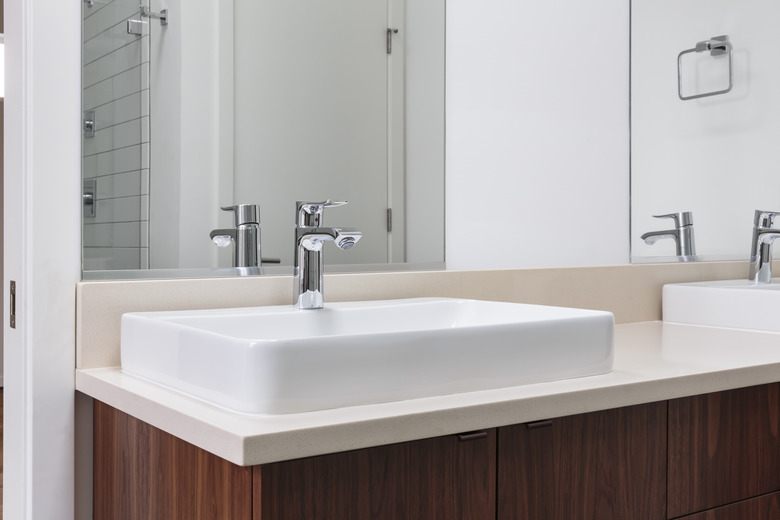How To Improve The Water Pressure In A Bathroom Sink
If a bathroom sink faucet is not delivering enough water pressure, but your showerhead and the rest of the faucets are working properly, adjusting the pressure regulator to raise household water pressure will not solve the problem. There are only three possible causes for low pressure at an isolated faucet: First, the shutoff valve under the vanity is the wrong type of fitting, it is partially closed or it is defective; second, the faucet aerator is partially blocked; or third, the pipe feeding water to that particular faucet is clogged.
How to Improve the Water Pressure in a Bathroom Sink
1. Fully Open Valve
Locate the shutoff valves feeding water to the bathroom sink faucet. Both are usually situated against the wall below the sink or inside the vanity cabinet. Turn the handle on the valve feeding water to your problem faucet counterclockwise to the fully open position. Test the water pressure at the faucet; if this does not fix the problem, go to the next step.
2. Remove the Aerator
Wrap a rag around the aerator fitted to the faucet outlet to protect its finish. Grip the aerator through the rag with a pair of tongue-and-groove pliers and twist counterclockwise to unscrew it. Test the pressure by turning the faucet on after removing the aerator; if there is plenty of pressure, clean the aerator.
3. Clean the Aerator
Soak all the aerator parts in white vinegar for 30 minutes to dissolve hard water deposits. Scrub the components with a stiff-bristle nail brush and rinse well. Reassemble the unit, screw it back on the spout and test the faucet; if the pressure is still low, carry out the next four steps.
4. Turn Off Water Supply
Turn the handle on the main household water shutoff valve to the "off" position. This valve is usually located on the downstream side near the water meter on the main pipe supplying water to your home.
5. Remove Sink Shutoff Valve
Open a bathroom faucet to relieve the remaining water pressure in the plumbing. Undo the flexible hose connected to the sink shutoff valve, using an adjustable wrench. Unscrew the compression fitting connecting the shutoff to the feed pipe with the adjustable wrench and remove the valve.
6. Determine Valve Type
Look inside the outlet pipe on the shutoff valve while turning the handle to the closed position. If you see a round copper ball below the handle rotate inside the opening, you have a ball valve. If you have to screw the handle down several turns to close the valve, you have a compression valve, which is probably faulty.
7. Replace Shutoff Valves
Pick up two of the same size ball-type shutoff valves from the nearest plumbing outlet. Replace both valves supplying water to the sink by attaching the compression fitting on the supply lines to the valves with an adjustable wrench. Reconnect the flexible pipes leading to the faucets, open the household water shutoff valve and test the faucet.
8. Call a Plumber
Call a plumber as a last resort if your original shutoffs below the sink turn out to be ball valves. Ask the plumber to check for leaks on the pipe feeding water to the sink and to test the water flow through the pipe. If there are no leaks and the home is plumbed with galvanized piping, the feed pipe is probably clogged with a combination of rust and hard water deposits and must be replaced.
